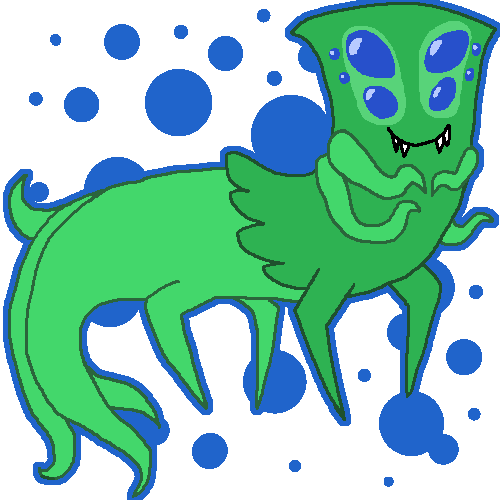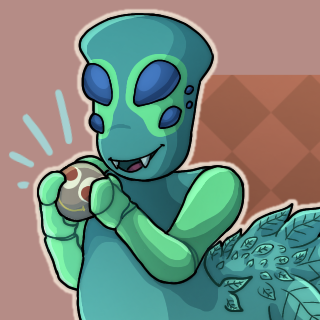[Cosmosdex] The Universal Encyclopedia
[Cosmosdex]
Celirack
Flytraps / Plant Stallions
Celirack

Art by, Glowymushroom
- Strength-4
- Intelligence-7
- Charisma-4
- Endurance-2
- Agility-7
- Luck-1
Common Jobs: Technician, Programmer, Engineer, Exterminator, Bodyguard
Likes: Debate, Technology, Inventing
Dislikes: Nature, Backing down from a fight
Attack Method: Hiding and striking when their prey gets close enough, or when in a rage blindly charging, bucking, kicking, biting and lashing their tails.
Attributes
Homeplanet: Unknown/Not ImportantLifespan: 150 years
Size: 5'1 ft tall, 7 ft long
Diet: Meat
Bodytype: Taur
Type: Plantoid
Social Class: Middle Class
Rarity: Uncommon
Common Traits
This character is graceful, but in a sort of odd way. Many will note that this character has an odd sort of grace, and is frankly sort of mysterious. This causes many other characters to pry more into them.
This character is more likely to be in tune with animals. While they cannot speak "animal" they are able to understand their emotions and the animal is likely able to understand them.
This character is easily agitated and if not given space they can burst into pure anger.
Gods
Celiracks do not worship any god so much as they treat nature much like the notails treat limbo gods; they live to spite it.
Gods: Neo
Original Creator: Creca
Rewritten by: Mel
Physical Description
Possibly the best description of the plant-based celirack's shape would be "centaur-like." Their body above the waist is upright and loosely rectangular. From their sides protrude two pairs of segmented arms tipped with thin, precise claws. On their slightly broader head sit two pairs of large eyes and two pairs of smaller ones above a wide, fanged mouth; surrounding each pair of eyes is a sort of mask of a lighter colour than the rest of their skin.
Below the waist, which is ringed by a skirt of leaves, their body splits into between three and five vines that wind around each other to the tip of their long tail. They are quadrupedal, each thin foot able to find every tiny purchase which allows them to scale sheer cliffs with ease. Their velvety skin comes mostly in shades of blue and green.
Personality
Celiracks have always been deeply in tune with nature. Their psychic abilities enable them to receive sensory input from all non-sapient life, both plant and animal, in a radius of around a hundred feet.
While bearable in barren areas, this grows quickly overwhelming in places full of life. Even a swarm of insects can send a celirack flying into a rage. The celirack will rampage, lashing out at everything in their vicinity, until they get rid of the perceived threat either by moving out of range or tearing it to shreds. While modern technology has made this much less of an issue, stress and danger can still make a celirack rampage at the drop of a hat.
As a result of their psychic abilities they despise nature, viewing it as a dismissive, merciless force with no regard for living things. Under a culture that views the outside world as hostile and terrifying, celiracks believe the universe at large as out to get them and no species other than their own can be trusted.
Fortunately, this idea is easy to dispel on an individual basis once a celirack leaves their home planet. The remnants of celiracks' once-warlike nature persist in a culture founded on debate and questioning. The easiest way to make a celirack ease up is to ask them for their opinion on something and engage them in a hearty discussion on it. A good debate partner will quickly win the admiration and trust of a celirack.
History
Once celiracks thrived in small communities based around barren rock fields. Apex predators, they would hunt by camouflaging against the rocks and lying in wait for large prey they could sense coming by piggybacking off smaller animals' and plants' senses. A good kill could keep a celirack fed for about a week.
As their population expanded the barrens grew overcrowded. Many celiracks were forced into greener habitats where the abundance of life overloaded their senses. Fierce wars sprang up over habitats shrinking as the population grew, and raged for centuries until finally the celiracks banded together against their true enemy: nature itself.
The decades during which celiracks waged their war on the wild became known as the Time of Smoke as toxic smog from the chemicals, bombs and fires turned the sky black. Had it not been for small groups of environmentalists across the globe all life on the planet would have been lost. Instead the government stopped the slaughter long enough to preserve millions of eggs and seeds before finishing the job.
On the heels of the Time of Smoke came the Time of Hunger. As celiracks struggled to stabilize their ruined planet, famine and war ravaged their civilization even further. Only in the last century with their discovery by other spacefaring races did they finally manage to repair the damage; by bolstering their technology with that of the aliens they cleaned their atmosphere, fixed their cities and finally mastered producing their food artificially. Once their most pressing issues were resolved, they terraformed their moon and populated it with their homeworld's extinct species, turning it into a flourishing wildlife sanctuary. It's mostly maintained by other species.
Now their homeworld is covered in cities and lights. It's turned into a hub of technology. With the harsh times of old now on the edge of memory, happy celiracks can tinker and invent without the pressure of life hammering at their heads.
Subspecies
Celunoll: Smaller and more aggressive, the celunoll have two rows of six spikes down their backs. There is no record of them before the Time of Smoke, so the main theory on their origin is that mutagens in the air from the pollution at the time caused them to split off from the main celirack species.
Celomeh: The celomeh have tentacles instead of arms and a powerful fin on the tip of their tail in lieu of legs. This water-dwelling subspecies is darker in colour than their landbound cousins and patterned with ripples for camouflage. They can venture on land for up to thirty minutes at a time, via a mobility aid or simply slithering, before they need to breathe water again. Most now carry equipment for this, but canals line many celirack streets to accommodate the celomeh anyway.
Special
Celimeleon: Celiracks can change the colour of their skin to blend in with their surroundings or make bright patterns. This is usually controllable, but can also happen as a reaction to being startled or frightened.
Trivia
• Modern technology has saved the spacefaring celirack a world of trouble. Those venturing to other planets can get implants in their heads to dull their psychic abilities against the cacophony of life to a bearable level. Research is still being done to see if the ability can be removed entirely or made possible to activate at will.
• As celiracks have never been able to tolerate other life, they have no concept of keeping pets. A celirack born on their home planet will be shocked at other species keeping them. Many assume the pet is an intruder and offer to kill it.
• Since the Time of Smoke the word "smoky" has gone through various permutations in celirack slang. Currently it's a catchall term meaning "bad."

